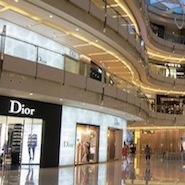- About
- Subscribe Now
- New York,
January 12, 2016

 Dior store in Chinese shopping mall
Dior store in Chinese shopping mall
It was a tumultuous start to 2016.
As the week began, amid a sudden devaluation of the RMB, the Chinese market plunged 7 percent, triggering a market suspension.
Instead of calming nerves, the market suspension – or “circuit breaker” mechanism – then arguably caused more panic, with shares falling yet again before stabilizing.
By the end of the week, the Chinese stock market had lost almost 10 percent, and the RMB nearly 2 percent. World markets followed suit, as fears of a Chinese slowdown and devaluation of the RMB spread.
So what has really happened, and what could 2016 have in store for China? And how will the luxury industry be affected?
Taking stock
While China's stock market gyrations made for sensational headlines, it is important to understand the nature and role of the Chinese stock market.
Unlike most world markets, where institutional investors provide funding to companies, in China more than 90 percent of the market is made up of retail investors who typically hold shares for an average of just five days. It is not a bourse that funds companies, nor do its valuations indicate the underlying health of the Chinese economy.
 Philip Guarino is Europe director of China Luxury Advisors in Paris
Philip Guarino is Europe director of China Luxury Advisors in Paris
Some liken the stock market to a slot machine where money is gambled purely for short-term gain – or loss, in the case of last week's events.
The real news is the slowdown in China’s growth and the devaluation of the RMB.
It is no secret that China’s economy has decelerated in the past year. Growth is also likely to remain subdued for some time as domestic – and global – demand remains weak.
On the one hand, Chinese officials are keen to stimulate domestic demand and accelerate the transition from an investment-led economy to one that is consumer-driven. Many would argue that officials quietly welcome a devaluation of the RMB, provided it is "orderly."
Yet it was the lack of order and clarity on the part of the Chinese leadership that generated panic on world exchanges.
Over the weekend, officials issued statements to calm investors’ nerves in advance of the week ahead.
Over the past year, there have been dramatic moves in currencies worldwide, specifically related to the U.S. dollar, which has risen in value against most currencies. Yet the value of the RMB has not followed suit.
To date, as capital flows have increased, the Chinese government has spent billions to prop up the value of the RMB. An adjustment was inevitable and necessary. And as China wants the RMB to be a freely traded currency, it has walked a fine line between its trust in markets and outright intervention.
On balance
Yet 2016 will see further downward pressure on the RMB, along with slower growth from China. But it is unlikely to see a meltdown.
 Shangri-La's new location in Hefei, China
Shangri-La's new location in Hefei, China
China’s fundamentals and balance sheet are strong. The country's expected growth of more than 5 percent per annum may seem weak compared to the past, but it is still far above what other countries are experiencing.
More people are becoming part of the country's middle class every day. And millions more Chinese are traveling abroad each year, learning about new brands and purchasing luxury goods.
While the momentum might slow, the trajectory is still positive. As such, brands would be best advised to take a longer view of the immense potential that China provides.
Perhaps 2016 will be the year in which slower growth in the luxury industry – particularly for those brands that have limited their China strategy to retail expansion and unproductive investment in mainland China – will spur executives to take a broader look at how they engage with Chinese consumers.
WITH AROUND 80 percent of luxury purchases by Chinese consumers made abroad, are brands dismantling unproductive silos and mechanisms that impede seamless customer experiences?
Are issues around compensation and loyalty that arise due to the lack of cooperation between country/regional managers and headquarters being addressed?
Are they using technology – particularly ecommerce and mobile commerce – in innovative ways that can expand their reach? Are they communicating with Chinese customers in the manner in which they want to be communicated?
These are some of the issues that senior luxury executives should be thinking about in 2016.
Philip Guarino is Paris-based director at China Luxury Advisors. Reach him at philip@chinaluxuryadvisors.com. Published with permission.
Share your thoughts. Click here